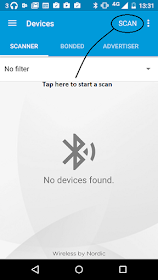이 코드는 다음의 기능을 다룬다.
* Advertising 및 connection 설정
* Input characteristic 만들기 : read-only, boolean with notification
* Service class 구축 및 BLE 스택에 추가하기
* 서비스와 characteristic에 UUID 할당
* Characteristic의 값이 바뀔 때 notification을 푸쉬하기
Running the application
Requirements
이 샘플 어플리케이션은 스마트폰의 어떤 BLE 스캐너에서도 볼 수 있다. 폰에 스캐너 앱이 없으면 다음의 앱을 설치하면 된다* nRF Master Control Panel for Android
* LightBlue for iPhone
하드웨어 요구사항은 main readme 를 참고하면 된다.
* 주의: 두개 이상의 mbed board를 가지고 있다면 (nrf51dk 또는 mkit) BLE_LED 와 BLE_LEDBlinker를 동시에 실행시킬 수 있다. 더 상세한 내용은 BLE_LEDBlinker 데모를 참고하면 된다.
Build Instructions
온라인 mbed 컴파일러에서 이 예제를 빌드하고 싶으면, 먼저 오른쪽의 'Import' 버튼을 사용해 예제를 import 해야 한다.그 다음 빌드한 코드를 실행하려는 플랫폼을 선택해 준다. 플랫폼은 예를 들어 NRF51-DK 같이 BLE를 지원하는 플랫폼이거나 또는 다음의 목록에 있는 것 중 하나여야 한다.
BLE를 지원하는 플랫폼 목록
또는 예를 들어 K64F나 NUCLEO_F401RE같은 보드에 X-NUCLEO-IDB04A1를 추가하고 그 하드웨어에 적합한 BLE 드라이버를 포함하는 지원 라이브러리를 설치해 줘야만 한다.
일단 플랫폼을 선택하고 나면 예제를 컴파일 한 후 바이너리 파일을 보드에 넣어주면 된다.
Checking for success
주의: 아래의 스크린 캡춰는 안드로이드에서 nRF Master Control Panel 버젼 4.0.5를 사용해 얻은 것이다. 버젼이 다르거나 아이폰을 사용하는 경우 버튼의 위치나 화면 레이아웃이 다를 수 있다.* 어플리케이션을 빌드한 후 바이너리 파일을 보드에 설치
* 스마트폰에서 BLE 스캐너 앱을 실행
* 스캔을 시작
* 디바이스를 찾는다. 'Button'이라는 이름을 가지고 있어야 한다.
* 디바이스와 connection을 설정한다.
* 디바이스의 service와 characteristic을 검색한다. *Button service*는 UUID '0xA000'을 가지고 있고 이 서비스는 UUID가 '0xA001'인 *Button state characteristic* 를 포함하고 있다. 사용하는 스캐너에 따라 비표준 16-bit UUID는 128-bit UUID로 표시될수도 있다. 만일 이런 경우라면 다음 포맷이 사용된다.
'0000XXXX-0000-1000-8000-00805F9B34FB' 에서 'XXXX' 부분에 16-bit UUID 값이 들어간다.
* button state characteristic의 notification을 등록한다. 그러면 버튼의 상태가 바뀔 때 마다 버튼의 새 상태를 포함한 notification을 자동으로 받게 된다.
* 보드의 버튼 1을 누르면 버튼의 상태가 업데이트 되고 스캐너로 notification을 보낸다. 버튼 characteristic 값의 새 상태는 0x01 이어야 한다.
* 보드의 버튼 1을 누른걸 떼면 버튼의 상태가 업데이트 되고 스캐너로 notification을 보낸다. 버튼 characteristic 값의 새 상태는 0x00 이어야 한다.
예제의 전체 소스코드는 아래 링크에서 BLE_Button 디렉토리를 보면 된다.
https://github.com/ARMmbed/mbed-os-example-ble
핵심 코드는 아래의 두 파일(ButtonService.h, main.coo)이다.
이 예제를 템플릿으로서 약간만 수정하면 동시에 여러개의 버튼 입력 또는 아날로그 센서값을 쉽게 받아올 수 있을 것이다.
ButtonService.h
/* mbed Microcontroller Library
* Copyright (c) 2006-2013 ARM Limited
*
* Licensed under the Apache License, Version 2.0 (the "License");
* you may not use this file except in compliance with the License.
* You may obtain a copy of the License at
*
* http://www.apache.org/licenses/LICENSE-2.0
*
* Unless required by applicable law or agreed to in writing, software
* distributed under the License is distributed on an "AS IS" BASIS,
* WITHOUT WARRANTIES OR CONDITIONS OF ANY KIND, either express or implied.
* See the License for the specific language governing permissions and
* limitations under the License.
*/
#ifndef __BLE_BUTTON_SERVICE_H__
#define __BLE_BUTTON_SERVICE_H__
class ButtonService {
public:
const static uint16_t BUTTON_SERVICE_UUID = 0xA000;
const static uint16_t BUTTON_STATE_CHARACTERISTIC_UUID = 0xA001;
ButtonService(BLE &_ble, bool buttonPressedInitial) :
ble(_ble), buttonState(BUTTON_STATE_CHARACTERISTIC_UUID, &buttonPressedInitial, GattCharacteristic::BLE_GATT_CHAR_PROPERTIES_NOTIFY)
{
GattCharacteristic *charTable[] = {&buttonState};
GattService buttonService(ButtonService::BUTTON_SERVICE_UUID, charTable, sizeof(charTable) / sizeof(GattCharacteristic *));
ble.gattServer().addService(buttonService);
}
void updateButtonState(bool newState) {
ble.gattServer().write(buttonState.getValueHandle(), (uint8_t *)&newState, sizeof(bool));
}
private:
BLE &ble;
ReadOnlyGattCharacteristic<bool> buttonState;
};
#endif /* #ifndef __BLE_BUTTON_SERVICE_H__ */
--------------------------------------------
main.cpp
/* mbed Microcontroller Library
* Copyright (c) 2006-2013 ARM Limited
*
* Licensed under the Apache License, Version 2.0 (the "License");
* you may not use this file except in compliance with the License.
* You may obtain a copy of the License at
*
* http://www.apache.org/licenses/LICENSE-2.0
*
* Unless required by applicable law or agreed to in writing, software
* distributed under the License is distributed on an "AS IS" BASIS,
* WITHOUT WARRANTIES OR CONDITIONS OF ANY KIND, either express or implied.
* See the License for the specific language governing permissions and
* limitations under the License.
*/
#include <mbed-events/events.h>
#include <mbed.h>
#include "ble/BLE.h"
#include "ble/Gap.h"
#include "ButtonService.h"
DigitalOut led1(LED1, 1);
InterruptIn button(BLE_BUTTON_PIN_NAME);
static EventQueue eventQueue(
/* event count */ 10 * /* event size */ 32
);
const static char DEVICE_NAME[] = "Button";
static const uint16_t uuid16_list[] = {ButtonService::BUTTON_SERVICE_UUID};
ButtonService *buttonServicePtr;
void buttonPressedCallback(void)
{
eventQueue.post(Callback<void(bool)>(buttonServicePtr, &ButtonService::updateButtonState), true);
}
void buttonReleasedCallback(void)
{
eventQueue.post(Callback<void(bool)>(buttonServicePtr, &ButtonService::updateButtonState), false);
}
void disconnectionCallback(const Gap::DisconnectionCallbackParams_t *params)
{
BLE::Instance().gap().startAdvertising(); // restart advertising
}
void blinkCallback(void)
{
led1 = !led1; /* Do blinky on LED1 to indicate system aliveness. */
}
void onBleInitError(BLE &ble, ble_error_t error)
{
/* Initialization error handling should go here */
}
void bleInitComplete(BLE::InitializationCompleteCallbackContext *params)
{
BLE& ble = params->ble;
ble_error_t error = params->error;
if (error != BLE_ERROR_NONE) {
/* In case of error, forward the error handling to onBleInitError */
onBleInitError(ble, error);
return;
}
/* Ensure that it is the default instance of BLE */
if(ble.getInstanceID() != BLE::DEFAULT_INSTANCE) {
return;
}
ble.gap().onDisconnection(disconnectionCallback);
button.fall(buttonPressedCallback);
button.rise(buttonReleasedCallback);
/* Setup primary service. */
buttonServicePtr = new ButtonService(ble, false /* initial value for button pressed */);
/* setup advertising */
ble.gap().accumulateAdvertisingPayload(GapAdvertisingData::BREDR_NOT_SUPPORTED | GapAdvertisingData::LE_GENERAL_DISCOVERABLE);
ble.gap().accumulateAdvertisingPayload(GapAdvertisingData::COMPLETE_LIST_16BIT_SERVICE_IDS, (uint8_t *)uuid16_list, sizeof(uuid16_list));
ble.gap().accumulateAdvertisingPayload(GapAdvertisingData::COMPLETE_LOCAL_NAME, (uint8_t *)DEVICE_NAME, sizeof(DEVICE_NAME));
ble.gap().setAdvertisingType(GapAdvertisingParams::ADV_CONNECTABLE_UNDIRECTED);
ble.gap().setAdvertisingInterval(1000); /* 1000ms. */
ble.gap().startAdvertising();
}
void scheduleBleEventsProcessing(BLE::OnEventsToProcessCallbackContext* context) {
BLE &ble = BLE::Instance();
eventQueue.post(Callback<void()>(&ble, &BLE::processEvents));
}
int main()
{
eventQueue.post_every(500, blinkCallback);
BLE &ble = BLE::Instance();
ble.onEventsToProcess(scheduleBleEventsProcessing);
ble.init(bleInitComplete);
while (true) {
eventQueue.dispatch();
}
return 0;
}








댓글 없음:
댓글 쓰기